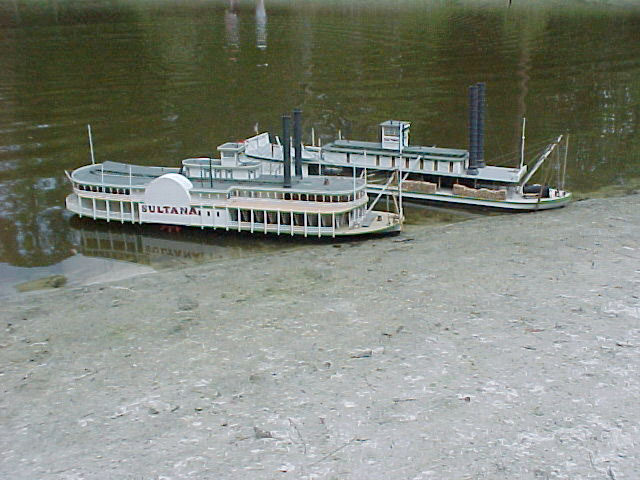
Radio Controlled Riverboats by Ralph Lossing
All photos by E.J. Drown
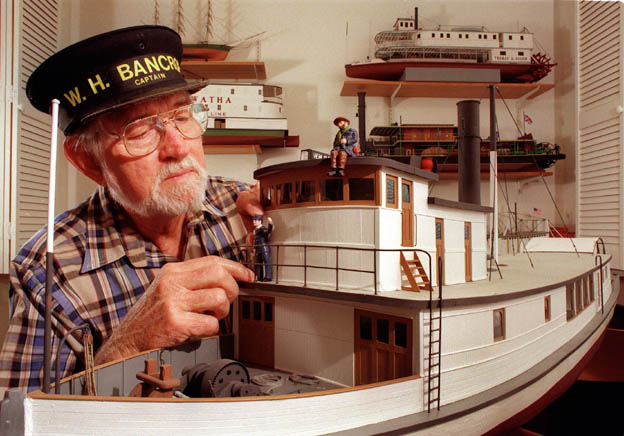
Ralph Lossing is seen working on one of his boats, with other model boats in the background
W. H. B A N C R O F T
1 / 24 Scale
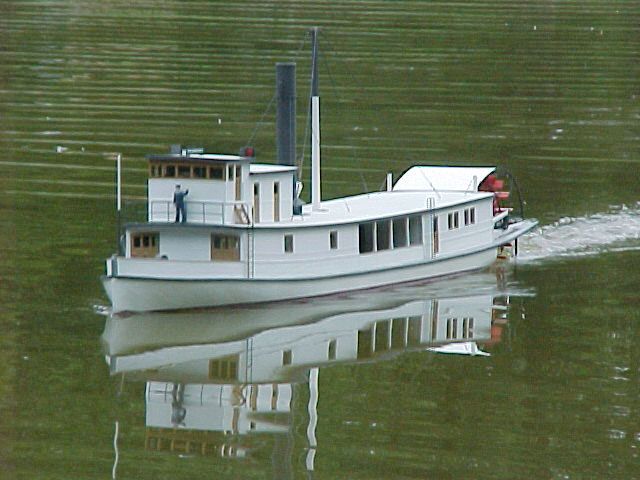
More history on this boat - excerpt from:
INTERNATIONAL MARINE ENGINEERING
November, 1912.
Situated at the mouth of the Copper River, Alaska, is what is known as the Orca Station of the Northwestern Fisheries Company, of Seattle , Washington. The cannery located at this station secures its principal supply of fish from the flats and shallow waters around the mouth of the river, and in order to transport the fish from the traps and seine boats where caught to the cannery it was necessary to provide a light draft vessel of considerable capacity for this work. Accordingly, plans for such a vessel were made under the directions of Mr. Frank Walker, marine surveyor and engineer, Seattle, Washington, and the contract for the construction of the boat was placed with Hall Bros. Marine Railway and Shipbuilding Company, Eagle Harbor, Winslow, Washington. The boat is a stern-wheel steamer named the W.H. Bancroft, and has the following principal dimensions:
Length of hull, exclusive of wheel housings - 111 feet.
Beam, molded - 26 feet.
Depth, molded - 5 feet, 6 inches.
The draft of this vessel at launching with the machinery on board was 18 inches. The load draft, with a maximum cargo of 125 tons of fish and with the bunkers full of coal, is 4 feet. The average speed when light is 10 miles per hour, and when loaded, 6 miles per hour.
*The above article is the only known historical data on this vessel. It is not known how long she engaged in her fish hauling trade, nor what other jobs she may have been used for. No other information, written or photographic, seems to exist of this vessel.
Model built by Ralph Lossing from plans by J.L Fryant and is electric powered and radio controlled.
THOMAS A. EDISON
1 / 24 Scale
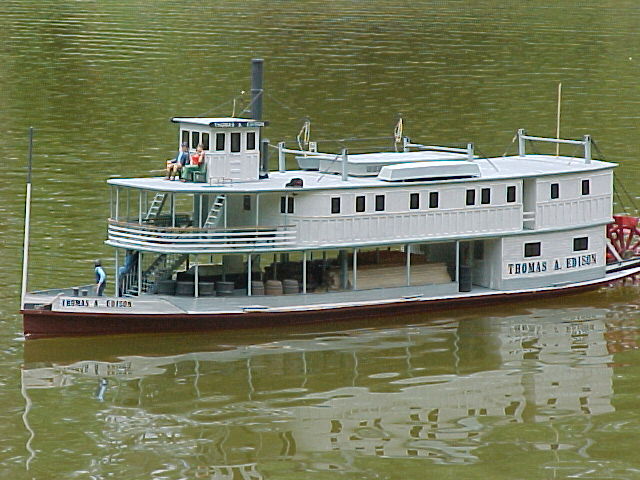
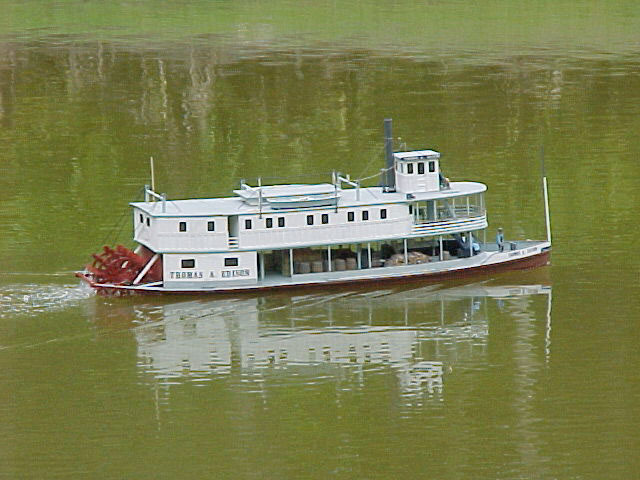
Built in 1904 (L.O.A. = 94 feet, Beam = 22 feet) at Appalachicola, Florida, for J. Fred and Conrad Menges, she ran passengers and light freight on the Caloosahatchee River between Ft. Myers and Thompson, piloted by Captain Nick Armeda. She was tied up at the Lee County Packing House with a full load of fruit on the night of January 30, 1914 at low tide. The packing house caught fire and was destroyed; the THOMAS A. EDISON, hard aground, went with it. The engines and machinery were recovered by order of Henry Ford and now power the stern-wheel steamer SUWANEE, carrying tourists at Ford's Greenfield Museum Village near Dearborn, Michigan.
Model built by Ralph Lossing from plans by John L. Fryant and is electric powered and radio-controlled. (J.L. Fryant is a nationally known steamboat and riverboat historian who has researched and drawn many plans for boats, and has built a number of models now in the Smithsonian collection.)
Z U L U
1 / 24 Scale

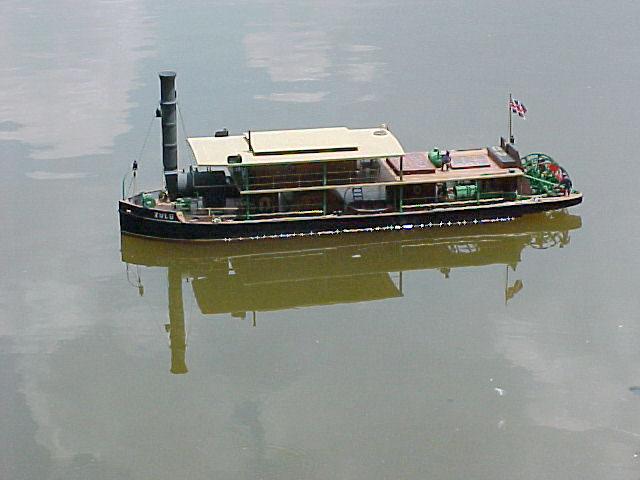
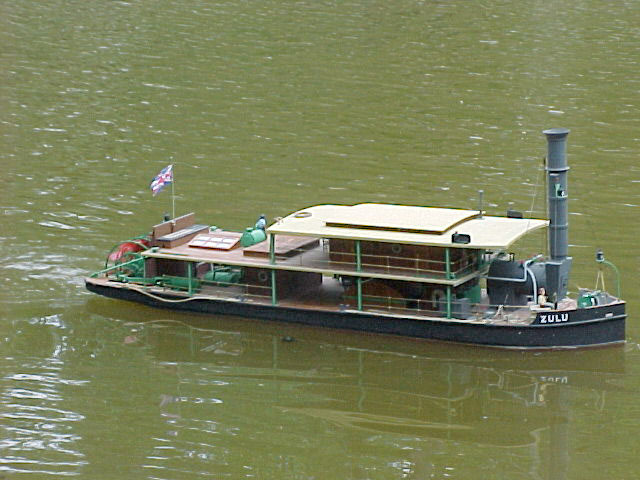
ZULU - a prototype of iron-hulled boats built on the Clyde by R. Duncan and Comp-any of Port Glasgow and Dennys of Dunbarton in England. After completion of the hull and machinery, they were disassembled, crated up in sections and shipped to their operating areas in Southeast Asia, Africa, and South America for re-assembly by bolting together the hull plates and installing the machinery. The cabins and superstructure were then built according to the needs of the operators. Some were located in Burma and India being operated by the Irrawaddi Flotation Company in the early 1900's; at least one was running on the Amazon River in Peru as recently as 1985.
Model built by Ralph Lossing and is electric powered and radio controlled
F A R W E S T
1 / 32 Scale
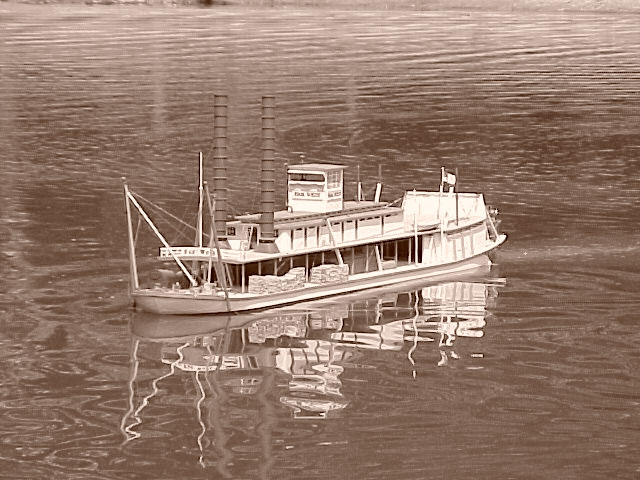
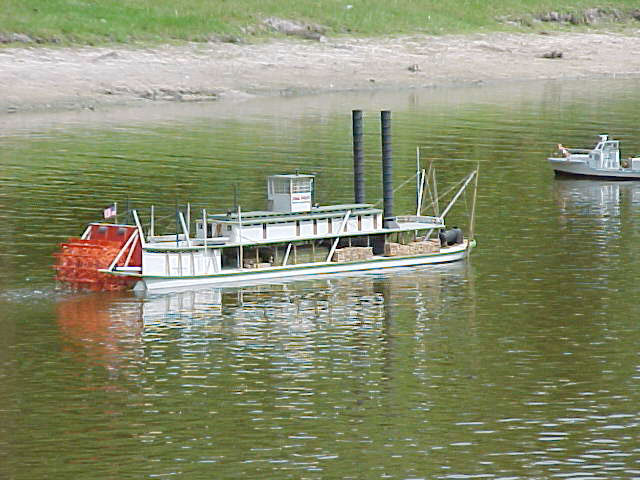
Built in 1870, the FAR WEST at 190 foot length and 33 foot beam drew only 20 inches light. She could carry 398 tons when loaded to her maximun draft of 4 feet 6 inches, 187 tons on only 3 feet of water, and 60 tons on 2 feet of water. Mountain boat super-structures were minimal to cut wind resistance and save weight; some boats had hurricane roofs, some did not. The FAR WEST had both arrangements during her lifetime, having a roof added late in her career. This model shows the configuration in the summer of 1876, when she was chartered from the Coulsen Packet Company to serve the Seventh Cavalry as supply boat, hospital ship, mobile command post and ferry. On October 30, 1883, she struck a snag and sank at Mulhanthy Island, 7 miles below St. Charles, Missouri.
More history on this boat:
The Indian Wars
The vessel of greatest renown in the Indian Wars was the FAR WEST, captained by Grant Marsh. This vessel's claim to fame was based primarily on her minor involvement in "Custer's Last Stand" in 1876. She began the campaign as a supply vessel for the command of General Terry, of which Custer's cavalry was a part. Terry's troops had marched out from Fort Lincoln, at Bismarck, North Dakota, to rendezvous with Gen-eral Gibbons' command on the Yellowstone at the mouth of the Powder River. As soon as the ice permitted, Marsh brought the FAR WEST up to Fort Lincoln, loaded her with 200 tons of supplies, and set out for the camp on the Yellowstone.
When the FAR WEST reached the rendezvous point at the mouth of the Powder River, she found Gibbons' command on one side of the Yellowstone and Terry and Custer on the other. She unloaded her supplies, returned downstream for more, and then became Terry's headquarters. In her cabin, Terry, Gibbons and Custer planned the tactics for the Indian campaign.
After Custer marched out with twelve troops of the Seventh Cavalry, the FAR WEST fer-ried Gibbons' troops across the river, then followed them upstream to the mouth of the Big Horn River, where eight days rations were issued from the supplies on the boat. Then Terry ordered the vessel to proceed up the Big Horn, if possible to the mouth of the Little Big Horn, to establish a forward supply base. This turned out to be a formid-able task; in some areas the troops had to carry cables ashore on both banks, and both port and starboard capstans were used to pull the boat up the middle of the river. While the men were sweating at this work they watched tall columns of smoke in the sky farther up the valley, caused, they believed, by the burning of Indian tepees by the victorious white troops.
On the afternoon of the second day the FAR WEST reached the mouth of the Little Big Horn and was moored to an island in midstream to guard against attack, after which everyone began fishing. Suddenly a mounted Indian, who proved to be Custer's scout, Curly, broke through the willows on the bank. On the deck of the FAR WEST the Crow scout, who spoke no English, drew a diagram of a little circle full of dots that he indicated were white men, surrounded by a larger circle with many more dots to which he pointed and repeatedly said, "Sioux, Sioux." He then made signs for being hit by bullets and scalped, and crossed out the dots in the little circle. Thus, on the deck of the FAR WEST, was filed the first report of Custer's Last Stand.
The next day an exhausted white courier arrived with the news from the infantry column that reached the battlefield to find the scalped and mutilated bodies of Custer and five troops of the Seventh Cavalry; Major Reno, Custer's subordinate, and the remaining seven troops had fought another action a few miles from the massacre site and held the Indians off for two days until relieved by the infantry. The FAR WEST was to prepare to receive Reno's wounded and take dispatches back to civilization. About two o'clock in the morning the sad column stumbled through the flickering firelight to lay 52 groaning wounded on the open deck aft of the boilers.
As the FAR WEST was preparing to pull out a lieutenant of the Seventh Cavalry who had been detached with Terry appeared on the bank with the sole survivor of the Custer massacre, the horse Commanche, mount of one of the troop captains. A grass-carpeted stall was hastily constructed at the stern of the vessel and the wounded animal was tenderly led aboard.
The dispatches that the FAR WEST brought out from the mouth of the Little Big Horn to Bismarck, North Dakota, were the world's first news of the Custer massacre. The vessel then traversed the the river to Fort Lincoln to carry the tragic news to the twenty-eight newly bereaved widows at that outpost.
From: Riverboats of America by Frank Donovan
More on the Custer incident: Captain Marsh brought the FAR WEST a distance of over 700 miles from the mouth of the Little Big Horn to Fort Lincoln at Bismarck, North Dakota, in 54 hours. They had averaged over 13 miles per hour, including wood stops, a delay at the mouth of the Powder River, and stops at two other forts. Actually, there were many times when the boat was running over 20 miles per hour in the swift downstream currents.
Model built by Ralph Lossing and is electric powered and radio-controlled.
S U L T A N A
1 / 48 Scale
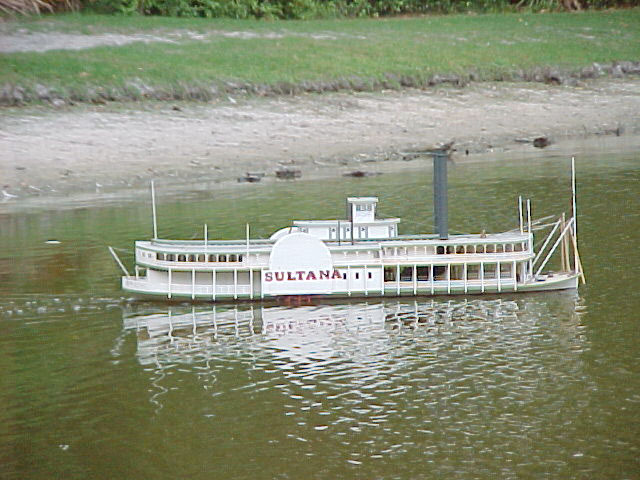
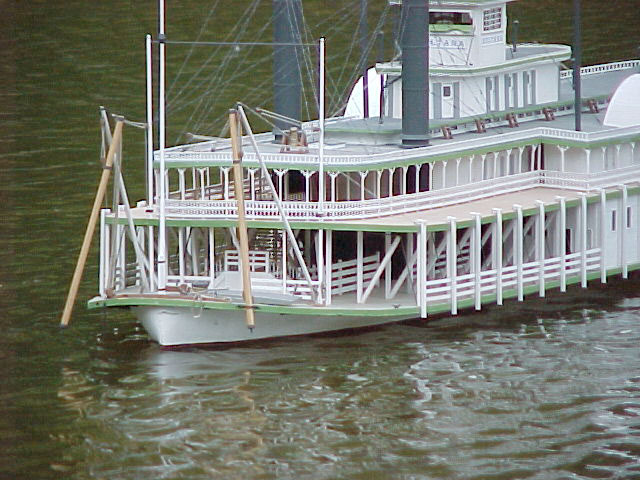
More history on this boat:
"LEE SURRENDERS!" "PRESIDENT MURDERED!" "BOOTH KILLED!" filled the headlines of American newspapers in April of 1865, leaving little room for mention of a maritime disaster that to this day stands as America's worst. At about 2:00 A.M. on April 27, 1865, the SULTANA, a 260-foot wooden-hulled steamboat - smaller than the TITANIC, but carrying more passengers - exploded on the Mississippi River a few miles north of Memphis, Tennessee.
The legal capacity of the SULTANA was 376 people; on board were approximately 2,500 people, including over 2,300 Union soldiers on their way home from Confederate prison camps at Andersonville and Cahaba. More than 1,800 people died, including her captain, J. Cass Mason. Extensive investigations over a period of years revealed the irresponsible conduct and criminal negligence that characterized the actions of an entire chain of Army command, high level political corruption reaching into the President's cabinet, and the profiteering schemes of various civilians that resulted in this tragedy.
On January 3, 1863, the SULTANA was launched into the icy Ohio River from the Lither-burg Shipyard at Cincinnati. Her principal dimensions:
Length . . . . . . . . . . . . . . . . . . . . . . . . . . . . . . . . . . . 260 feet
Beam (hull) . . . . . . . . . . . . . . . . . . . . . . . . . . . . . . . . .42 feet
(at guards) . . . . . . . . . . . . . . . . . . . . . . . . . . . 70 feet approx.
Hold depth . . . . . . . . . . . . . . . . . . . . . . . . . . . . . . . . . . 7 feet
Draft trimmed . . . . . . . . . . . . . . . . . . . . . . . . . . . . . . . 34 inches
From: THE SULTANA TRAGEDY by Jerry O. Potter
Model built by Ralph Lossing from plans by David J. Meagher and is electric powered and radio-controlled.
S U L T A N A & F A R W E S T
1 / 48 Scale - 1 / 32 scale
